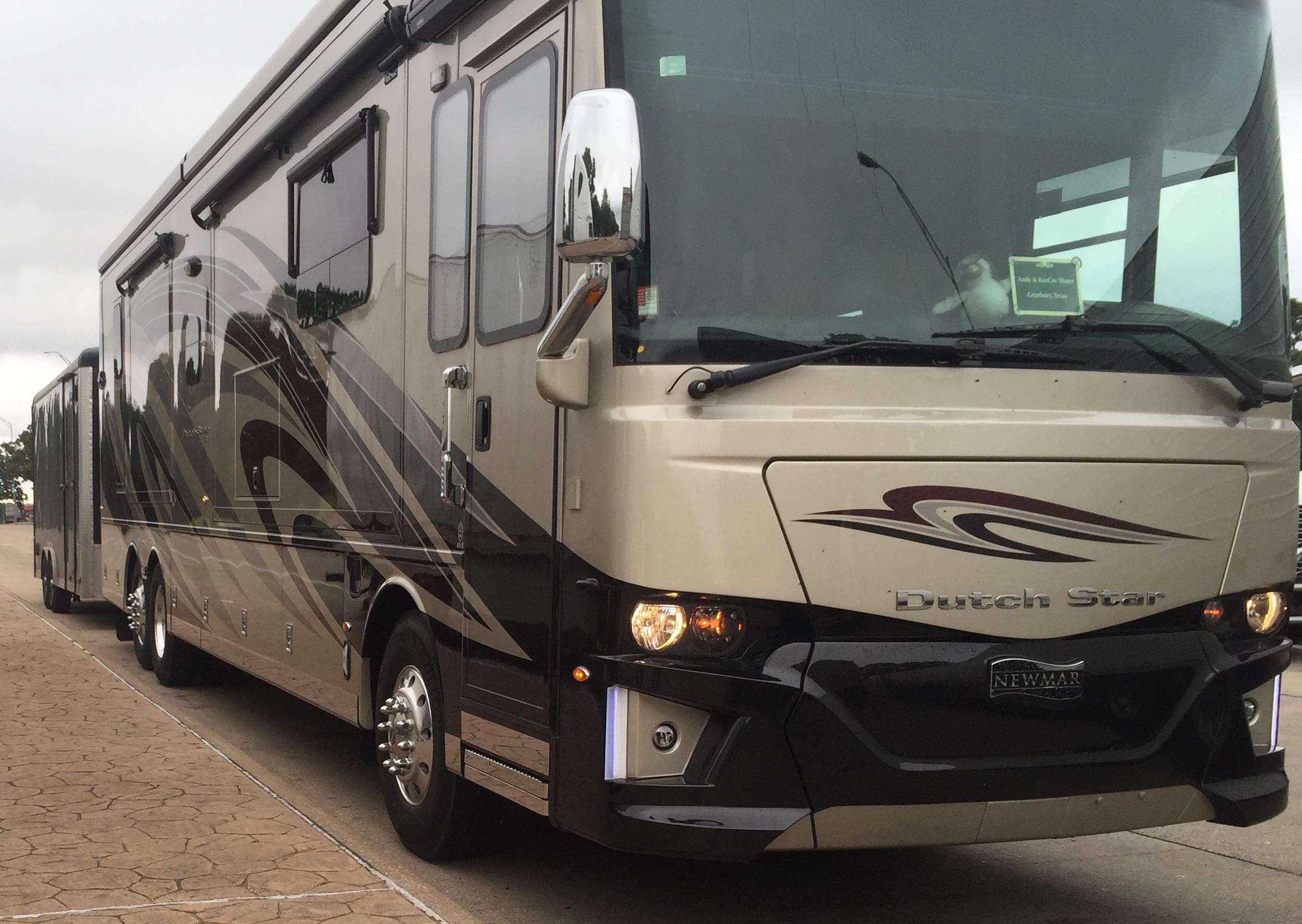-
Content Count
257 -
Joined
-
Last visited
-
Days Won
4
Posts posted by andyshane
-
-
I did the all routine stuff, then noticed that the fan blades felt gummy... Sure enough, my regular pressure washing (using Delicate tip for radiator halves, of course) after applying copious degreaser wasn't doing the trick.
It took an hour of scrubbing with degreaser and a stiff-bristled brush, reaching down through the bedroom closet floor, to get those blades looking pretty...
One thing I'll do more of this season: pull my speed back and downshift to increase my rpm, when the temp creeps over 200F.
"Understanding Coach/RV Performance" is a publication distributed by Caterpillar, they briefly address cooling in the C7 engine.
-
We've had two dollies (one borrowed to test the concept and then the one I bought), think it is the most economical way to go.
Now, after some 30 overnights, we've yet to find a place where the dolly was a hassle. The worst case I encountered was at the ABQ Balloon Fiesta, where I had to march it 50 yards to the fence line, lock it, leave it with others.
My hookup and takedown time is equal to a 4-down person; one of us has to bend over and hook up the safety chains. One day, that might knock us out of the running; but, for now, no sweat...
Something else that might propel you into 4-down: storage when not traveling. I've got 3,600 feet of garage floor, at home, so it's not a problem.
-
At the bottom of the chart there was a footnote to add another 5 lbs for safety. Therefore, mine were 90 lbs rear and 90 lbs in the front. I was getting some cupping of the right front right tire at 45,000 miles. A GoodYear factory representative at Perry, GA convention stated that I should add another 5 lbs in all tires.
I have PressurePro and cannot say that I am satisfied. The seals are not very good.
Thanks, Mr. B!
Maybe Michelin has rolled that value into their RV tables, eg the note is absent.
Indeed, lots of Goodyear owners have cupping problems. My next door neighb at the ABQ Balloon Fiesta in October showed me his Goodyears, marked cupping on his steering tires. His tires had half the miles on them I had on ours. It makes sense to add pressure for that: shifts the load towards the center of the tire.
'Sure be nice to know if cupping sufferers also had higher temps, before they upped the psi.
BTW, my tires need air no more frequently with TireTraker than without the sensors. I wonder if valve core depth has an effect, eg if the core is set just above the threshold for conveying pressure to the sensor it'd be less prone to leak... I don't know.
-
I've enjoyed reading the thread, take an interest in tires. 'Will tell you what I've been doing, hope you can point me to something written by either the manufacturers of the Natl Hwy Tfc Safety Admin about adding a safety margin. 'Never heard that term before, want to learn more about it.
First, someone was talking about Michelin data pertaining to total axle weight; I was prompted to dig out my guide and re-read the introduction from the tire manufacturer.
For RV use only, Michelin displays tire loads per axle end in theload and inflation tables, as we recommend weighing each axleendseparately and using the heaviest end weight to determinethe axle's cold inflation tire pressure.I highlighted the operative term that caught my eye.
If my math is correct, that gives you a margin of a total front axle weight up to 11,380 lbs on 90 psi. True, some of the company's tire charts refer to total axle weight; but, my RV table deals with axle-end.
After re-reading my Michelin stuff and the NHTSA guidelines, I keep coming up with the inflation table values as "recommended" rather than "minimum," and would like to hear if I've been under-inflating mine. All my crosschecks suggest that inflating to the recommended value for the rounded-upward heaviest axle-end weight is optimum for the tire itself: I've been running 85 psi in my 275/70R22.5 LRJ XZE2 Energy model with 7,000 miles of decent handling, perfect tread wear distribution and a peak running temp (IR scan, not stem temp) of 120F.
Any additional information is greatly appreciated. Super thread!
-
This is why I routinely scroll through all my tire pressures on the TPMS as part of my preflight.
I'm interested in your comment about adding 5psi. Not objecting to the practice, since it is definitely not a safety problem; but, the engineers came up with those table pressures to give (for one) optimum contact patch, and it seems odd that a company rep would advocate essentially reducing customers' traction (albeit a tiny amount)...
I'm fully prepared to add 5 or 10 psi if a tire ends up hotter than 120F at a safety check. But, to date, adhering to Michelin tables exactly has produced 120F running temp on the hottest days; so, no need to reduce temps with extra pressure. Industry consensus is that we should never let our tires go above 180F.
-
-
Hello again, SeaJay. I hope you're doing okay, know it has been a difficult year. Here's your info.
Captain Norris D. "Andy" Shane, USAF 1978-1988 Instructor Pilot, KC-135A 7AREFS, Carswell AFB, Texas Eldorado Canyon, 1986
(Small potatoes compared to TSgt Norris D. Shane, 1927-2007, 1943-1946 US Navy; 1947-1977 US Air Force, Normandy, 1944. His plaque is on the wall among thousands of veterans' at The National Museum of the Pacific War in Fredericksburg. My beloved Uncle Dave thought it was a big deal, me going to pilot training, flying; despite his persistent habit of getting busted in rank, I'd consider his career the stellar one. Still healthy and robust at 81, the undisputed heart throb of his retirement complex, he was unexpectedly felled by a heart attack.)
-
We've just wrapped up our first year in our first rig. It's been a learning experience, for sure!
Some lessons learned that might help guide you:
- Experienced owners agree that gas is better suited to infrequent use, diesel is best for an RV that drives regularly
- A diesel pusher is quieter when driving because the engine is not up front, between the two seats
- Contrary to intuition, having the engine in the back makes for better stability, eg passing trucks generally don't sway diesel rigs, while some gassers will exit the lane when a large truck passes them
- Diesel reliability is enhanced by diligent filter changes
- Diesel engine longevity is much better than gas engines; but, maintenance on diesels, when it's needed, is more expensive
- In general terms, a gas engine is performing nearer to its rated capacity doing RV duty. In diesel pushers, the engine is often performing a fraction of the work it was engineered to do, eg long-haul trucking
We have a 2005 Fleetwood Excursion 39S with 95,000 miles. It runs like a watch, travels down the highway as if on rails. We bought it from friends, who put 15,000 miles on the rig in a single long trip. Aside from vinyl-clad cabinet framework and Hehr windows that fog at the five-year point, I've found the craftsmanship to be on par with much more expensive rigs. The biggest layout shortcoming is a "pinch point" at the top of the entry steps. This rig has the Spartan MM chassis; both Spartan and Fleetwood reps have been helpful when needed.
By the way, the friends who'd sold us this RV and upgraded to a Newell disliked their new bus so much they sold it and now own a 2003 Fleetwood Discovery.
It's no secret that the market is in a slump, you should be able to purchase a good rig for close to wholesale throughout 2012.
Best of luck!
- Experienced owners agree that gas is better suited to infrequent use, diesel is best for an RV that drives regularly
-
I'd love to hear from someone who switched from one to the other, on the same rig.
At the large, poorly-managed forum, there has been lots of discussion about tire wear, heat*, inflation, general safety.
For one, I've just put 7,000 miles on XZEs with good results, and a decent ride. It'd be interesting, to see the difference; with 5-year replacement** of my steering tires coming up next year, I'm tempted to try out a pair of XRVs based on this discussion.
*Rather than depending on the stem temperature sensed by the TPMS, I use a cheap IR scanner to check tires each hourly stop. My goal is to limit tire temps to 120F. Experience has shown, strict adherance to the manufacturer's tables (avoid using sidewall values or the "sticker" pressure inside the rig) will produce 120F max on the hottest days. Without exception, a higher temperature has meant that the inflation had slipped below Michelin's charted minimum.
** My personal technique only. Given the critical role of the steering tires, I want to replace them before age can possibly be a factor. Manufacturer's guidance applies for tires on the duals.
-
I too had a negative experience with GS, would strongly advise against them.
Specifically, I had a $200 claim stemming from a split boot on my Spartan MM chassis; GS decided that was a gasket, refused coverage. Since I'd not placed another claim, I involved the Better Business Bureau (BBB) and petitioned GS for a refund of premiums paid, about nine months' worth.
GS ignored both me and the BBB.
-
I'm here from I RV Too after terminating my Senior Membership (647 posts and blog). 'Was looking to see if others had made the same discovery I had, this thread came up on Google.
Looking across the FMCA threads, it seems to be free of hijacks/trollings, a problem that some members and even staff at the other forum perpetuate.
Moderation is okay, and no moderation is alright. What I cannot stomach is selective moderation, which seemed to be taking a foothold there. Truly, there are some wonderful people inhabiting the forum; the staff simply needs to sort out some internal problems before it once again becomes a good place to talk RVs.
For now, mostly lurking. I hope to contribute later, if appropriate.




Overheating Cat 330-Discovery
in Engines
Posted · Report reply
Good point.
If you're lucky enough to have a power washer with a "Delicate" tip, it might be okay: vigilance and a little common sense is the key.